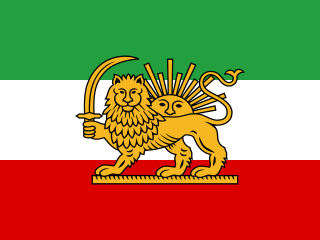
Seyyed Mohammad Hosseini Beheshti was an Iranian jurist, philosopher, cleric and politician who was known as the second person in the political hierarchy of Iran after the revolution. Dr. Beheshti is considered to have been the primary architect of Iran's post-revolution constitution, as well as the administrative structure of the Islamic Republic. Beheshti was assassinated along with more than 70 members of the Islamic Republic Party on 28 June 1981.

The Iranian Revolution, also known as the Islamic Revolution or the 1979 Revolution, was a series of events that involved the overthrow of the last monarch of Iran, Mohammad Reza Shah Pahlavi, and the replacement of his government with an Islamic republic under the Grand Ayatollah Ruhollah Khomeini, a leader of one of the factions in the revolt. The movement against the United States-backed monarchy was supported by various leftist and Islamist organizations and student movements.

Behesht-e Zahra, is the largest cemetery in Iran. Located in the southern part of metropolitan Tehran, it is connected to the city by Tehran Metro Line 1.

Ardeshir Zahedi, GCVO is a former Iranian diplomat who served as the country's foreign minister (1966-1971) and its ambassador to the United States and the United Kingdom during the 1960s and 1970s.

Karim Sanjabi was an Iranian politician of National Front.

The demonstrations of June 5 and 6, also called the events of June 1963 or the 15 Khordad uprising, were protests in Iran against the arrest of Ayatollah Ruhollah Khomeini after his denouncement of Iranian Shah Mohammad Reza Pahlavi and Israel. The Shah's regime was taken by surprise by the massive public demonstrations of support, and although these were crushed within days by the police and military, the events established the importance and power of (Shia) religious opposition to the Shah, and Khomeini as a major political and religious leader. Fifteen years later, Khomeini was to lead the Iranian Revolution which overthrew the Shah and his Pahlavi dynasty and established the Islamic Republic of Iran.

Cultural Foundation of Refah (formerly Refah School was an elementary school for girls in Tehran, Iran. It gained historical significance in the 1979 Iranian Revolution when it was the temporary headquarters of the revolutionists lead by Ruhollah Khomeini. It was also used for the Islamic Revolutionary Court and the execution of officials of the second Pahlavi Regime on its rooftop before being transformed into what is being currently used as, a cultural and educational institution.

This article is a timeline of events relevant to the Islamic Revolution in Iran. For earlier events refer to Pahlavi dynasty and for later ones refer to History of the Islamic Republic of Iran. This article doesn't include the reasons of the events and further information is available in Islamic revolution of Iran.
Nimatullah, also spelled Ni'matullāh, Nematollah etc. is a male Muslim given name, is used mostly in Arab countries, also used by Arab Christians.

Observers differ on how many people died during the Iranian Revolution. The number of casualties suffered by protesters and revolutionaries at the hands of the Shah's monarchy during the revolution is either close to 60,000, or around 2,000, depending on whether the estimates used are those of Islamic government or from historians in Western countries. The number of protesters and political prisoners killed by the new theocratic republic after the fall of the Shah is estimated by human rights groups to be several thousand.
Ayatollah Nematollah Salehi Najafabadi was an Iranian cleric and proponent of Islamic Unity, who spent most years after the Iranian revolution of 1979 under house arrest.

Hassan Alavikia was a prominent general and businessman in the Pahlavi pre-revolutionary government of Iran. Along with Teymur Bakhtiar and Hassan Pakravan, he was a co-founder of the SAVAK.

Parviz Sabeti is an Iranian lawyer, former SAVAK deputy under the regime of Mohammad Reza Shah Pahlavi. Born in Sangesar, Semnan province, in north-central Iran, to a Bahá'í family, Sabeti received a law degree from the University of Tehran and joined the SAVAK, Iran's intelligence agency in Shah's regime, in 1957, and quickly rose to become the acting director of the SAVAK's so-called third division—its political directorate—and later its director.

Sepahbod Amir Hossein Rabii was an Iranian senior military officer who served as the commander in chief of Imperial Iranian Air Force from 1976 to 1979. He was the last commander of the force.

Fajr decade is a ten-day celebration of Ruhollah Khomeini's return to Iran in 1979. The annual celebration is held between 1 and 11 February. Its beginning coincides with the date of Khomeini's arrival and its ending with the Iranian Revolution; a day called Islamic Revolution's Victory Day or 22 of Bahman.

Ruhollah Khomeini's life in exile refers to the period that Grand Ayatollah Ruhollah Khomeini spent from 1964 to 1979 in Turkey, Iraq and France, after Mohamed Reza Shah Pahlavi had arrested him twice for dissent from his “White Revolution” announced in 1963. Ayatollah Khomeini was invited back to Iran by the government,and returned to Tehran to a greeting by several million Iranians.



















